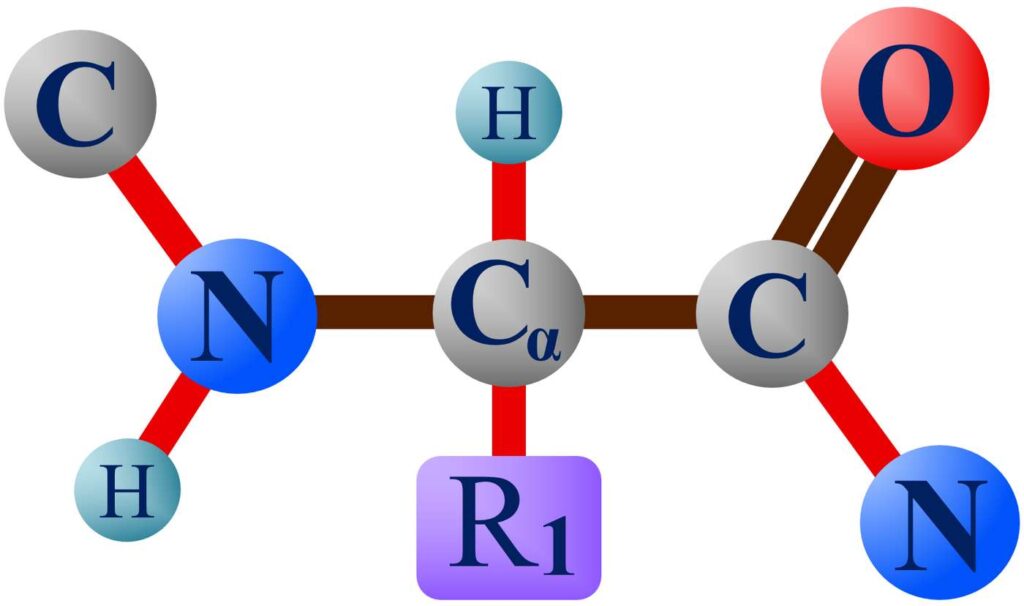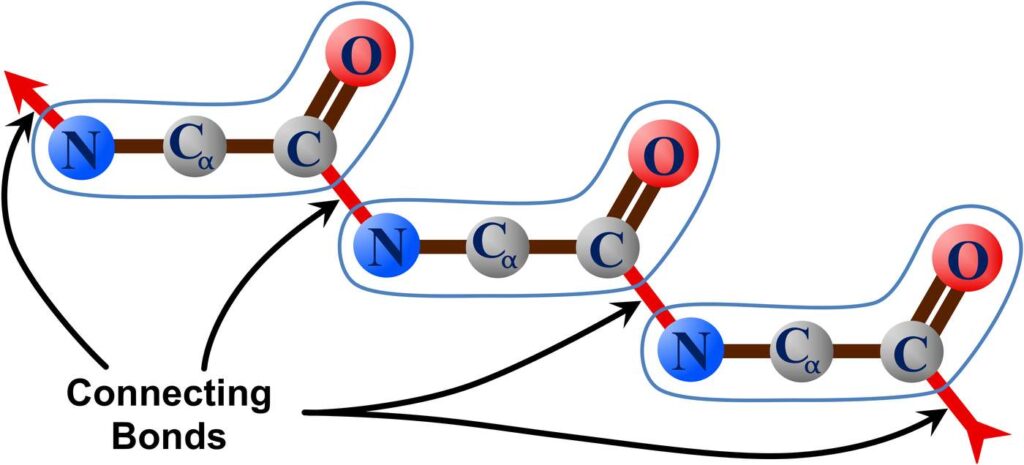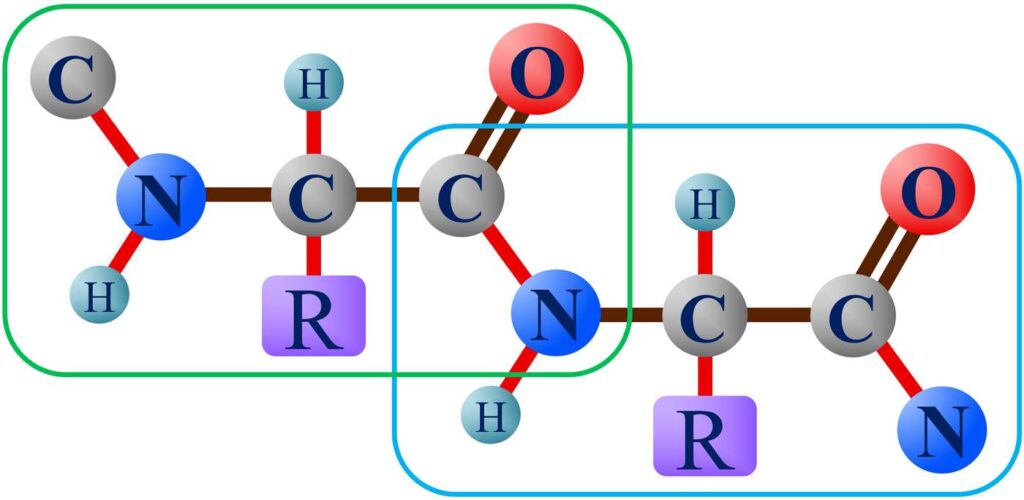Chapter 9
Peripheral Bonds and Protein Function
The Findings of Chapters 9 and 10
Chapters 9 and 10 are difficult, so to help readers know where we are headed, we will quickly preview the most important findings of these two chapters.
(1) The mind signature includes all four atoms of the core amino acid.
(2) A mind must have governing control over the peripheral bonds of its mind signature. This information will be used to identify the atoms of the minderelle. Once this has been done, we will know exactly which atoms a mind can act on with forces. These atoms will be shown in Figure 17, which is copied here.

Figure 17. You. The minderelle is the full body of matter governed by a mind for all conscious beings throughout the universe.
(3) Adjacent amino acids within a protein will share governing control over the molecular bond that joins them together. The amino acids within a protein will communicate with each other across these shared bonds.
(4) The amino acids of different proteins communicate with each other across hydrogen bonds.
(5) Protein folding is a controlled process made possible by minds having governing control over their dihedral angles.
Many readers may prefer to skip the next two chapters for now and return to them after finishing the book. The material of these two chapters should be considerably easier after seeing it applied. If this is your preference, you should familiarize yourself with the five findings above and then move on to Chapter 11, “The Source of Consciousness.”
The Communication Requirement
We have accepted that the mind signature can have no more than the four atoms of the core amino acid, the atoms found at the center of the amino acid. We have also accepted that the mind can govern the cardinal bonds that join the mind signature atoms to each other. We have not yet determined if the mind can govern its peripheral bonds.
But even if a mind can govern its peripheral bonds, then at most, a mind’s range of action can never extend beyond the amino acid to which it belongs.
This limitation on the mind’s range of action is important because proteins are made up of thousands of amino acids. If each mind can only use forces to govern the bonds and atoms of its own amino acid and there are thousands of amino acids in a protein, then proteins could only be functional if the actions of all the amino acids are coordinated and synchronized.
We know from human experience that two-way communication is necessary to coordinate the functional activities of many individuals working in a changing and unpredictable environment. Humans will set up centralized command posts in these environments. Workers in the field will collect information and transmit it back to the command post.
The command post will evaluate all the incoming information and then transmit commands back to the field workers so their efforts will be coordinated. The field workers will now report back on which commands were successfully carried out and which were not along with any newly collected information. The command post will now make new decisions based on this new data.
In unpredictable and changing environments, getting effective action from many participants requires two-way communication. Functional decisions cannot be made if information cannot be sent to the command post, and the efforts of the many workers cannot be coordinated if commands cannot be sent out. Without two-way communication, group efforts could not be effective in these environments.
We will apply this understanding to proteins.
Without feedback, we would have the primary issuing commands with no knowledge of the protein’s situation or surroundings, and without commands, we would have thousands of minderelles acting independently of each other. Without two-way communication, effective protein function would not be possible.
The question is, how do the many amino acids of a protein communicate with one another?
Communication Within Proteins
To comply with the conservation laws, we found that conscious minds must act on matter using geometry locks. Therefore, the many individuals within proteins will have to use geometry locks to communicate with one another. But there is a problem.
Figure 15 shows three core amino acids within a larger protein where the core amino acids have been enclosed by blue lines. Now notice that there is an additional connecting bond that joins the adjacent core amino acids together.

Figure 15. Three core amino acids are shown within a larger protein. Notice that an additional bond connects the adjacent amino acids together. If the minds of two adjacent amino acids could not govern the bond between them, then this natural bond would become an isolating barrier.
If the conscious minds of a protein were not able to impose geometry locks on the connecting bonds that join them together, then these connecting bonds would isolate all the amino acids of the protein.
However, if conscious minds could impose geometry locks on their connecting bonds, then communication could take place across these bonds. Length locks could now be used to generate the 1’s and 0’s needed for communication. Because proteins are functional, and because this function requires communication, we now accept that minds do have governing control over their connecting bonds.
These connecting bonds cannot be cardinal bonds, but they could qualify as peripheral bonds.
Identifying Three Mind Signature Atoms
Because proteins are functional, and because proteins could only be functional if communication is taking place across the connecting bonds, we now accept that the connecting bonds must be peripheral bonds and that minds do govern their peripheral bonds. For the connecting bonds to be peripheral bonds, the atoms at each end of the connecting bonds will have to be mind signature atoms.
We can see from Figure 15 that there is a nitrogen atom at one end of each connecting bond and a carbon atom at the other end. We now accept that both of these atoms belong to the mind signature molecule.
Now notice in Figure 15 that the Cα atom lies between these two atoms. This Cα atom must also belong to the mind signature so that the mind signature will be a single molecular structure as it was defined.
We have now accepted the following:
(1) For this free will paradigm to be consistent with known observations, minds must have governing control over the peripheral bonds of the mind signature.
(2) Each connecting bond within a protein is a peripheral bond for two mind signatures at the same time. Notice in Figure 15 that adjacent minderelles will share governing control over the connecting bond between them.
(3) We have accepted that the mind signature includes at least three of the four core amino atoms – the nitrogen atom and the two carbon atoms. We are still uncertain about the oxygen atom.
We accepted that minds govern their peripheral bonds based on the necessity of communication between the amino acids of a protein. However, we will soon see that this finding is consistent with known observations for the other peripheral bonds as well.
The Oxygen Atom and the Mind Signature
We must now determine if the oxygen atom belongs to the mind signature. To do this, we will begin by assuming that the oxygen atom does not belong to the mind signature. Without the oxygen atom, we will find that the mind signature violates the free agent rules, and this would mean an unknowable universe. Therefore, we will accept that the oxygen atom must belong to the mind signature. We will now begin the argument.
Let us assume that the oxygen atom does not belong to the mind signature. Without the oxygen atom, the mind signature would have the three atom molecular structure found in the previous section, nitrogen–carbon–carbon, or N–C–C.
However, the N–C–C molecule creates a forbidden symmetry problem. If the mind signature configuration were N–C–C, then every molecule in the universe that includes this N–C–C structure would have to be conscious because by definition, the molecular structure of a mind signature must always be conscious.
This means that a conscious mind would necessarily be present in the many molecules that include C–C–N–C–C because the N–C–C mind signature is found within. But this creates a problem that can be seen in Figure 16. Does the mind’s existence depend on the three atoms to the right, or on the three atoms to the left?

Figure 16. If the mind signature were N–C–C, then the many C–C–N–C–C molecules would violate free agent rule #3. In the figure, which three atoms give the mind its presence, the three atoms to the right or the three atoms to the left?
Recall that if a free agent exists, we must be able to discover its existence, and we must be able to identify exactly the atoms that give the mind its presence (free agent rule #3). This free agent rule is necessary so that science can identify all the atoms that can be acted on with forces by a mind.
If N–C–C were the mind signature, we would not be able to identify exactly the atoms that a mind can act on with forces for the many C–C–N–C–C molecules. This would mean the existence of atoms that could not be scientifically understood, which would leave us with an unknowable universe. Therefore, we cannot accept N–C–C as the mind signature.
However, if the mind signature were to include the oxygen atom, it would now have the asymmetry needed to unequivocally identify the life-critical atoms of the mind. Thus, we now accept that the oxygen atom, when it has a double bond to the core amino acid, must belong to the mind signature. The double bond is required because oxygen atoms have double bonds within proteins, and our starting point was the proteins within cells.
We have now accepted that the mind signature includes all four atoms of the core amino acid. For four atoms to be a core amino acid, the atoms must be the right elements in the right order with the right bonds joining them together.
The consciousness of these four atoms begins when the four-atom molecular structure first forms and continues as the same conscious being until the core amino acid is structurally compromised. Wherever there is a core amino acid, there is a conscious mind, and there can be no conscious life apart from this basic molecular structure.
The Minderelle, You
Earlier in this chapter, we found that conscious minds have governing control over their peripheral bonds. When a mind governs a bond, it can exert equal and opposite forces on the two atoms that form the bond. Thus, a mind can exert forces on the four atoms of the mind signature, and on all the atoms joined to the mind signature by covalent bonds.
This takes us back to the definition of the minderelle. Recall that the minderelle includes all the atoms the mind can act on with forces. Figure 17 shows the atoms and bonds of the minderelle.

Figure 17. You. The minderelle is the full body of matter governed by a mind for all conscious beings throughout the universe.
Because a mind can only govern across the covalent bonds of its mind signature, the mind will only be able to exert forces on the first atom of the R-group structure. This makes the first atom of the R-group structure part of the minderelle, while the other atoms of the R-group do not belong to the minderelle.
It is important to remember that the bonds joining the four core amino atoms together are cardinal bonds – if any of these bonds is broken, the life and consciousness of the structure will come to an end. The peripheral bonds of the minderelle are not life-critical bonds. Consistent with our earlier findings, the peripheral bonds of the minderelle can be broken without ending the life of the structure.
Clarity on Definitions for Living Molecules
For the sake of future discussions, we should make clear that the mind signature includes both the matter and the mind, while “core amino acid” refers only to the matter itself. Therefore, even though the matter is the same, “core amino acid” and “mind signature” are not interchangeable.
The minderelle and the amino acid are also closely linked even though the matter between them is not identical. “Minderelle” refers to both the matter and the mind while “amino acid” refers only to matter.
Shared Bonds
If a mind can govern across all the bonds of its mind signature, then adjacent minderelles within a protein will share the covalent bond that joins them together, as shown in Figure 18. This makes the bonds between neighboring minderelles not only living bonds, but shared bonds. Figure 18 shows two adjacent minderelles in a protein, one enclosed by a green line, the other enclosed by a blue line. Notice that the bond between the neighboring minderelles is shared by both minderelles.

Figure 18. We found that minds govern across all the bonds formed by the mind signature, so neighboring individuals within a protein will share governing control over the bond that joins them together.
Newton’s Third Law and Shared Bonds
The matter that makes up a shared bond belongs to two minderelles simultaneously – it is shared matter. In Chapter 5, in the section “Newton’s Third Law,” we found that “external forces acting on the minderelle must affect the thoughts of the mind.” The forces exerted on a shared bond by one minderelle will be outside forces to the other minderelle, so a length lock imposed by one minderelle across a shared bond will be unmistakably known to the other minderelle.
Thus, shared bonds will make fast, bi-directional, and error-free communication possible along the full length of the protein’s backbone. There is a problem, though.
Sharing bonds could lead to a violation of the conservation laws. If both minderelles were to length lock their shared bond at the same time, this would double the force needed to immobilize the bond against external forces. Instead of locking the bond, this excess of force would cause the bond length to change. The minds would now be doing work in violation of the conservation laws. We will address this problem in Chapter 14.